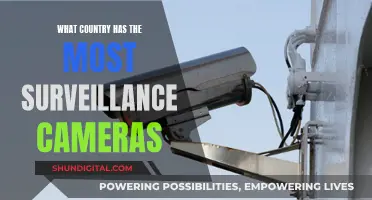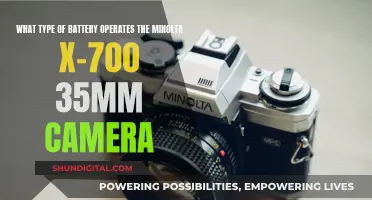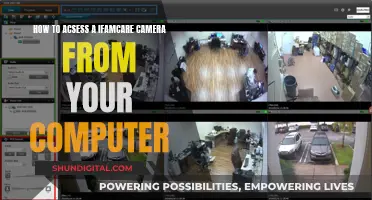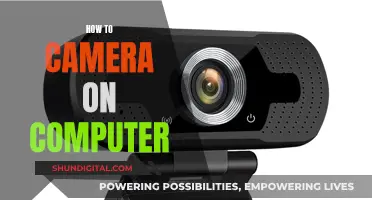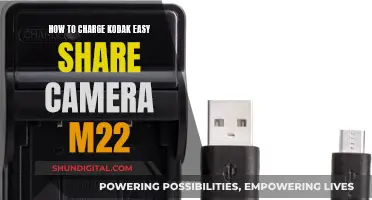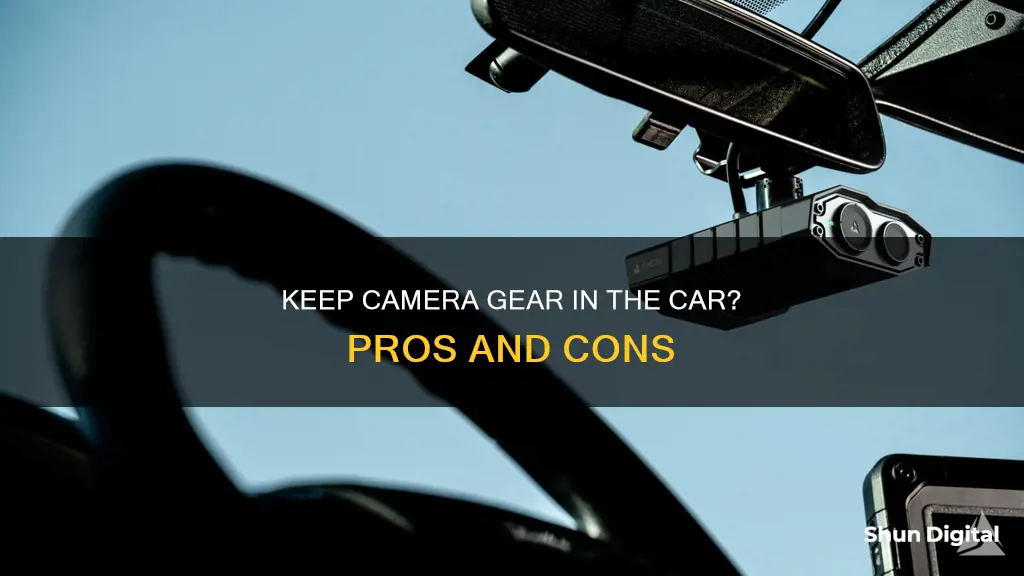
Keeping camera gear in the car is not recommended. The extreme heat inside a car can damage the camera's delicate parts and cause long-term damage. It is also a theft risk, as thieves often target photographers and their equipment. If you must leave your camera gear in the car, take precautions such as keeping it in a well-ventilated area, using a cooler, and concealing it from view. Additionally, assess the risks of your travel destination and consider getting insurance for your equipment.
| Characteristics | Values |
|---|---|
| Temperature | The temperature inside a car can soar to over 120°F |
| Damage | Cameras can be damaged by heat and UV light |
| Storage | Store camera gear in a bag, in the trunk, or under a seat and out of direct sunlight |
| Theft | Camera gear is a target for thieves |
| Condensation | Condensation can occur when moving from air conditioning to hot weather |
What You'll Learn

Heat damage
To protect your camera gear from heat damage, it is recommended to never leave your equipment in a hot car. If you need to leave your camera in the car for a short period, move it to the trunk, which is generally cooler than the passenger compartment. You can also invest in a foldable insulated bag to provide an extra layer of protection against heat. Additionally, keep your gear in a camera bag or protective case, and allow it to cool down before use.
Black cameras are particularly susceptible to heat damage, as they absorb heat more readily. If you have a black camera, take extra precautions such as covering it with a reflective cloth or towel when shooting in hot weather.
It is also important to be mindful of the temperature and humidity ratings of your camera gear. Most cameras are rated for temperatures between 0 and 40ºC (32-104ºF), and prolonged exposure to higher temperatures can lead to damage. Check your camera's manual for specific ratings and recommendations.
In addition to heat, humidity can also pose a threat to your camera gear. Condensation can form when moving between air-conditioned spaces and hot outdoor environments, and this moisture can shorten the life of your lens and cause mould to grow. To combat this, allow your camera to acclimate gradually to the outside temperature before shooting. Desiccants can also help control humidity levels in your camera bag.
Are Rexing Dash Cams Charging? A Quick Guide to Know
You may want to see also

Theft
Leaving camera gear in your car makes it vulnerable to theft. Opportunistic thieves are often on the lookout for valuables left in vehicles, and expensive camera equipment is an attractive target. In one incident, a photographer's $7,000 worth of gear was stolen while they were stuck in traffic. The thieves smashed the car window and grabbed the equipment bag from the trunk. Such brazen thefts are not uncommon, and leaving your gear unattended in your vehicle invites trouble.
To reduce the risk of theft, avoid leaving your camera gear in your car whenever possible. If you must leave it unattended, place it out of sight, preferably in the trunk or a locked glove compartment. Covering your equipment with a blanket or towel can also help deter thieves. Additionally, consider investing in a car alarm system or a GPS tracking device for your equipment, which can aid in recovery if it is stolen.
Taking these precautions will help lower the chances of your camera gear being stolen from your vehicle. Remember that thieves often look for easy targets, so making it more difficult for them to spot and access your equipment can go a long way toward keeping it safe.
Loading Camera Raw Presets: XMP Files Explained
You may want to see also

Condensation
To prevent condensation, it is crucial to understand the concept of Dew Point Temperature. This is the temperature at which water vapour in the air will condense. When moving between environments, if your camera is at or below the Dew Point Temperature, condensation will form. Therefore, it is essential to keep your camera equipment above the Dew Point Temperature.
- Protect Your Camera: Use a rain cover, a plastic bag, or a sandwich bag to cover your camera and prevent it from getting wet.
- Keep Your Camera Warm: In cold environments, keep your camera close to your body to utilise body heat. You can also use specialised products like the Camera Duck All Weather Cover, which includes heat packets to keep your camera warm.
- Allow Your Camera Gear to Acclimatise: When moving between environments with drastic temperature differences, place your camera gear inside your camera bag and keep it closed. This will help regulate temperature changes and prevent condensation. Depending on the temperature difference, you may need to leave your gear in the bag for several hours.
- Use a Camera Bag or Airtight Bag: The padding in camera bags acts as insulation, helping to regulate air temperature changes. Placing your camera inside a plastic ziplock bag before entering a new environment provides an extra layer of protection.
- Avoid Wiping the Lens: If condensation has already formed, avoid wiping the lens as it will only cause streaks. Instead, let the condensation dissipate naturally.
- Do Not Detach the Lens: Keep the camera and lens together to avoid introducing condensation to other parts of the lens or the camera's internal mechanisms.
- Use Moisture-Absorbing Materials: Place your camera gear inside your camera bag with silica gel packets or ziplock bags of silica kitty litter to absorb moisture. Alternatively, use a Hydrosorbent silica dehumidifier tin to protect your equipment.
- Gradual Acclimatisation: When moving between environments, gradually introduce your camera to the new temperature. For example, if moving from a cold environment to a warm one, avoid direct exposure to hot air or sunlight.
The Ultimate Camera Bag for A-Mode Photography
You may want to see also

Transporting gear
Transporting your camera gear safely is a key consideration for any photographer. Here are some tips to help you keep your equipment secure and in good condition while on the move:
- Avoid leaving your camera gear in the car: Extreme temperatures can damage your equipment. The inside of a car can get very hot, especially in direct sunlight. This heat can affect delicate parts of your camera and cause long-term damage. It is best to avoid leaving your camera gear unattended in a vehicle for prolonged periods.
- Protect from heat: If you must leave your camera gear in the car, take steps to protect it from the heat. Park in the shade, cover your car with a light-coloured sheet, and use a window shade to create your own shade. Keep the windows down, and if you have an SUV, keep the hatch up. You can also use a cooler with ice packs to keep your gear cool, but be cautious to avoid condensation.
- Conceal your equipment: Try to keep your camera gear out of sight to deter potential thieves. Use a nondescript bag that doesn't scream "expensive gear inside". You can also use a towel or cloth to cover your equipment and hide it from view. In addition, avoid wearing expensive jewellery or clothing that makes you look like a rich tourist when travelling with your camera gear.
- Secure your equipment: Lock your camera gear in the trunk of your car or cable lock multiple bags together to make it more difficult for thieves to grab and run. Always keep your camera gear with you when exiting the vehicle, and never leave it unattended.
- Blend in: When travelling to unfamiliar locations, try to blend in with the local environment and culture. Learn some key phrases in the local language to help you get around and communicate with locals. Avoid looking like a lost tourist, as this can make you a target for thieves.
- Be vigilant: Stay alert and aware of your surroundings, especially in busy areas or when using public transportation. Keep your camera gear close to your body, and avoid wearing fanny packs or putting your wallet in back pockets, as these are easy targets for pickpockets.
- Travel with a partner: There is safety in numbers. Consider travelling with a friend or partner, especially in areas that may be unsafe. A companion can help you keep an eye on your gear and deter potential thieves.
- Keep your gear accessible: When transporting your camera gear, use a bag that allows easy access to your equipment. This will enable you to quickly grab your camera and capture that perfect shot without fumbling around.
- Plan ahead: Whenever possible, plan your shoots in advance to minimise the amount of time your gear spends in the car. Know where you are going and what you need to bring, so you can transport only the essential equipment.
Galaxy S8 Camera Mode: Where Is It?
You may want to see also

Insurance
Keeping your camera gear in your car can be a risky business. Accidents happen, and if you're a professional photographer, your livelihood depends on your equipment. If you're an amateur, your camera gear is likely to be among your most valuable possessions. Either way, insurance is a must.
Homeowner's or Renter's Insurance
If you're a non-professional, your camera gear will be covered by your homeowner's or renter's insurance policy. This type of insurance is relatively cheap and easy to obtain, but it's important to note that it won't cover you if you're making money from your photography. It also often has a high deductible and a relatively high depreciation value for electronics.
Personal Articles Insurance Policy
This type of policy offers photographers much more protection than a basic homeowner's or renter's policy. You can schedule your equipment, ensuring you get the full replacement value of your gear without any depreciation. However, these policies still usually carry a deductible, and they won't cover professional photographers.
Professional Policies
If you're a professional photographer, or even making a small income from your photography, you'll need a professional policy. These policies are more expensive, but they're the only ones that will protect you if you're earning money from your craft.
Extra Coverage
If you want to insure your camera gear against accidental damage and mysterious disappearance, you'll need to take out extra coverage. This will protect your gear against accidental loss and any accidental physical damage.
Replacing Camera Batteries: Powering Your Camera with AC
You may want to see also
Frequently asked questions
No. The inside of a car can get very hot, and the prolonged exposure to high temperatures can damage your camera gear.
Most cameras are rated for temperatures between 0 and 40 degrees Celsius, or 32 to 104 degrees Fahrenheit.
If you have to leave your camera gear in the car, there are a few things you can do to keep it cool: park in the shade, cover your car with a light-coloured sheet, and use a cooler with ice packs.
In addition to heat damage, you should also be concerned about theft. Never leave your camera gear unattended in the car, and consider getting insurance for your equipment.
Yes, here are a few tips: blend in with your surroundings, don't leave your gear unattended, and keep your gear in a secure location (e.g. a locked hotel safe).


